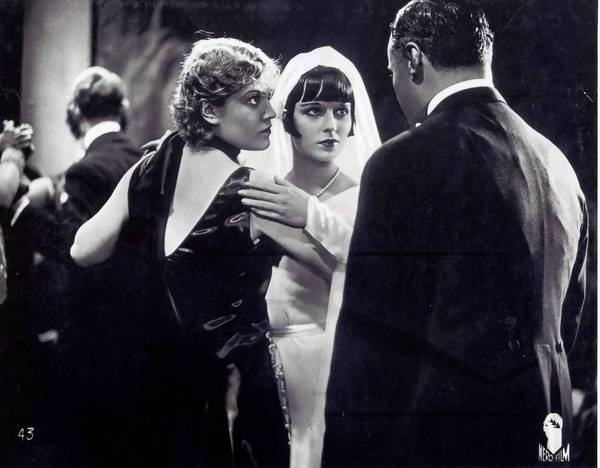 REEFER MADNESS (1936); Dir: Louis Gasnier; Starring Dorothy Short, Kenneth Craig; Starts Friday, February 15.; The Plaza Theatre; Trailer here.
REEFER MADNESS (1936); Dir: Louis Gasnier; Starring Dorothy Short, Kenneth Craig; Starts Friday, February 15.; The Plaza Theatre; Trailer here.
By Andrew Kemp
Contributing Writer
REEFER MADNESS is invading your town. Your children could be next….or yours…. or YOURS.
REEFER MADNESS is one of those films that cast a huge shadow for reasons that have nothing to do with quality: the plot of the movie is pretty standard for a 1930s hand-wringer, the cast is clumsy, and the production values are Ed Wood-cheap. Still, the film’s campy charm and incredibly sincere doofiness has helped elevate it to true cult status. REEFER MADNESS was cult before cult was cool.
The plot is suitably scandalous. Bill (Kenneth Craig) and Mary (Dorothy Short) are teenagers in love. They play tennis together, take walks together, and even discuss Shakespeare while sipping hot chocolate on Mary’s idyllic patio. But when a sinister drug dealer lures Bill into the corrupt wonderland of an apartment run by Mae (Thelma White), just one puff of “marihuana” is enough to send Bill down into a spiral of sex and murder that dooms the sweet, chaste Mary as well. The film’s cautionary tale is spun by a stern high school principal demanding parents warn their children about the dangers of smoking reefer—a drug more dangerous than opium, heroin or any other narcotic known to mankind!
This is all fairly standard propaganda, but REEFER MADNESS stands apart by virtue of its total, dedicated dunderheadedness. What the hell are these kids smoking? To hear the film tell it, smoking marijuana causes fits of maniacal laughter followed by hallucinations, temporary insanity, rabid sexual urges and even permanent psychosis. But, despite apparently being laced with Joker gas, marijuana was then and remains today a cornerstone of the counterculture. People know the plant, we know what it does, and it definitely looks like a different weed in REEFER MADNESS. Few things cheer up the underground as when the mainstream gets it so terrifically wrong.
 The origins of REEFER MADNESS are hazy. A church group supposedly funded the film to promote marijuana awareness, but there seems to be no real record of which church paid the money or how they acquired a budget hefty enough to hire a bunch of Hollywood B-movie players. A rumor claims the film was really bankrolled by the federal government as part of Harry Anslinger and William Randolph Hearst’s anti-marijuana campaign, but there’s more speculation than evidence to support this. The film seems to have appeared in a puff of truly excellent smoke, cashed in by filling a few programming slots under titles like TELL YOUR CHILDREN and THE BURNING QUESTION, and then faded into obscurity.
The origins of REEFER MADNESS are hazy. A church group supposedly funded the film to promote marijuana awareness, but there seems to be no real record of which church paid the money or how they acquired a budget hefty enough to hire a bunch of Hollywood B-movie players. A rumor claims the film was really bankrolled by the federal government as part of Harry Anslinger and William Randolph Hearst’s anti-marijuana campaign, but there’s more speculation than evidence to support this. The film seems to have appeared in a puff of truly excellent smoke, cashed in by filling a few programming slots under titles like TELL YOUR CHILDREN and THE BURNING QUESTION, and then faded into obscurity.
Enter Bob Shaye, a young entrepreneur in late-1960s New York City. After getting a good laugh at a screening of REEFER MADNESS, he realized that one could get mighty rich screening a hilarious anti-weed polemic on college campuses. And get rich he did. Shaye’s newly-founded production company, New Line Cinema, made millions screening the public domain film, and the cult of REEFER MADNESS has been growing ever since. Today, a fan can find REEFER MADNESS posters, merchandise and colorized versions of the film. In 1998, Dan Studney and Kevin Murphy (of MYSTERY SCIENCE THEATRE 3000 fame) created the musical version, REEFER MADNESS!, which later received its own film adaptation.
 Since the original REEFER MADNESS is in the public domain, there are oodles of ways to see it. You could see it alone right now on your couch if you chose to, but why would you do that? REEFER MADNESS is a group project. Like THE ROCKY HORROR PICTURE SHOW (1975), THE ROOM (2003) or the up-and-comer MIAMI CONNECTION (1987, and also back at the Plaza this week), most of the joy of REEFER MADNESS comes from hearing a crowd full of people in the know laugh their heads off at whatever unbelievable scene they just saw. You should definitely see REEFER MADNESS with a crowd at the Plaza, but if you do, please remember that marijuana is a scandalous, dangerous drug and unfit for public consumption. What you do in Mae’s apartment, or your own, is completely up to you.
Since the original REEFER MADNESS is in the public domain, there are oodles of ways to see it. You could see it alone right now on your couch if you chose to, but why would you do that? REEFER MADNESS is a group project. Like THE ROCKY HORROR PICTURE SHOW (1975), THE ROOM (2003) or the up-and-comer MIAMI CONNECTION (1987, and also back at the Plaza this week), most of the joy of REEFER MADNESS comes from hearing a crowd full of people in the know laugh their heads off at whatever unbelievable scene they just saw. You should definitely see REEFER MADNESS with a crowd at the Plaza, but if you do, please remember that marijuana is a scandalous, dangerous drug and unfit for public consumption. What you do in Mae’s apartment, or your own, is completely up to you.


